|
|
If you happen to be in Melbourne, Australia, this weekend, I will be speaking at Parallax, the Australian National Architecture Conference.  My subject will be architectural media, broadly speaking, in a dual session co-hosted with Aaron Betsky: The role of the media in disseminating architectural theory and practice has been debated as long as media has engaged with architectural practice and production. These debates – pitting access to information against authenticity of mediated versus real experience – have become even more complex in the contemporary environment where magazines are joined by blogs, YouTube, Facebook and web alerts.
We are interested in the veracity of these various forms of media and in the types of architectural activity and architects they promote. Will architectural tendencies change as modes of media evolve? How are the two related? In addition to myself and Betsky, the conference also features Tatiana Bilbao, Sou Fujimoto, Alejandro Zaera-Polo, Veronika Valk, Winka Dubbeldam, Bijoy Jain from Studio Mumbai, Edwin Chan, Peter Wilson, and, last but not least, Slavoj Žižek. This is in addition to a number of other speakers who will be leading workshops throughout the conference. For instance, I'm also scheduled for a workshop – again, on "Architectural publishing: The future" – with Winka Dubbeldam and Andrew MacKenzie, editor-in-chief of Architectural Review Australia. Finally, I'll also get to meet, after nearly five years of emails, the legendary Mr. Marcus Trimble from Super Colossal. This will be at a live design critique hosted in a Melbourne pub Friday night; other judges include Slavoj Žižek, Aaron Betsky, Edwin Chan, Bijoy Jain (Studio Mumbai), Veronika Valk, and Peter Wilson, and it will all be moderated by Leon van Schaik. While I'm at it, let me add that I'm also excited to meet architect Andrew Maynard, as well as Simon Sellars from Ballardian. So while my time in Melbourne will be short, unfortunately – and hopefully swine flu-free – if you happen to be around this week, it'd be nice to meet. Regular posts will resume shortly...
 [Image: "People wear surgical masks as a precaution against infection inside a subway in Mexico City, Friday, April 24, 2009." Photo by AP Photo/Marco Ugarte].
1) [Image: "People wear surgical masks as a precaution against infection inside a subway in Mexico City, Friday, April 24, 2009." Photo by AP Photo/Marco Ugarte].
1) In his under-appreciated novel Super-Cannes, easily amongst his best, J.G. Ballard explored the psychological, sexual, and even epidemiological implications of landscape design. This is "the secret life of the business park," Ballard writes.
At one point the book's narrator is speaking with the corporate director of Eden-Olympia, a planned live/work community in southern France. The director somewhat off-handedly refers to medical research that the narrator's own wife, a doctor, has been performing: "She's running a new computer model," the director says, "tracing the spread of nasal viruses across Eden-Olympia. She has a hunch that if people moved their chairs a further eighteen inches apart they'd stop the infectious vectors in their tracks."
Perfectly calibrated down to the inch – or perhaps the millimeter – modern space itself becomes a kind of medical regime, its bare white rooms an antiviral treatment that we mistake for interior design.
Just as our city streets are wide enough to accommodate the turning radius of a specific class of passenger vehicle, our office cubicles, kindergarten playrooms, courts of law, and university lecture halls could be measured against the infectious vectors of specific pathogens.
In the geometry of objects around us are the outer infectious edges of diseases we no longer suffer from; we have literally designed them out of modern space, denying their ability to spread.
2) You go to the Salone del Mobile next year in Milan and discover that the CDC has unexpectedly released a new line of furniture. Each piece varies just slightly from the rest, in that their measurements have been dictated not by human comfort, international rates of shipment, or even by industrial timber specifications, but by the distances medically necessary to maintain between yourself and others in order to avoid respiratory infections.
The common flu is now a dining table measured exactly against the reach of sneezes; SARS is a cubicle lined with an industrial felt that absorbs all coughs; pneumonia is a bar stool, hand-crafted from white pine, with a circumference of rails to prevent people getting too close.
3) The recent outbreak of swine flu in and around Mexico City and the U.S. border region, is "suspected of killing at least 60 people," the BBC reports. In fact, the outbreak "has the potential to become a pandemic," according to Margaret Chan, current director of the World Health Organization.
Chan has "confirmed the virus was an animal strain – a mixture of swine, human and avian flu viruses," which the BBC points out "is a classic 're-assortment' – a combination feared most by those watching for the flu pandemic."
 [Image: Like the beginning of a zombie horror film, we read – via Twitter – "SWINE FLU SPREADING, CANNOT BE CONTAINED" (via @alexismadrigal)]. [Image: Like the beginning of a zombie horror film, we read – via Twitter – "SWINE FLU SPREADING, CANNOT BE CONTAINED" (via @alexismadrigal)].
It's interesting to note, however, that swine flu, unsurprisingly, comes from "close contact with pigs" – that is, spatial proximity between humans and their livestock.
Swine flu, we could say, is a spatial problem – an epiphenomenon of landscape.
I'm reminded here of a point made recently by geographer Javier Arbona. Referring to the increasingly popular and somewhat utopian idea that, in the sustainable cities of tomorrow, agriculture will have returned to its rightful place in the city center, Arbona asks: "Did everyone think that so much lushness and farming envisioned in the city aren’t going to open up new Pandora’s boxes of infectious diseases and sanitation problems as we come into contact with more manure, more bacteria, and more wild animals that we urbanites are not at all 'naturalized' to?"
It's an important question. After all, it's incredibly easy, reading about sustainable cities, urban agriculture, and even the locavore movement, to conclude that chickens, pigs, cows, etc., have all been removed from the urban fabric as part of a profiteering move by Tyson and Perdue.
But there were very real epidemiological reasons for taking agriculture out of the city; finding a new place for urban farms will thus not only require very intense new spatial codes, it will demand constant vigilance in researching and developing inoculations. Few people want to see burning piles of livestock in Times Square or Griffith Park, let alone piles of human corpses infected with H5N1.
Indeed, one of the most prevalent, if mundane, reasons why avian flu has become a "global threat" to humankind, as Mike Davis refers to it in his book Monster At Our Door, is space: it sounds like a joke, but people are living too close to their chickens (or their pigeons, as the case may be).
Avian flu, foot-and-mouth disease, swine flu: if these are spatially activated, so to speak, and spread through certain unrecommended proximities between humans and animals, then urban design's medical undergirding is again revealed.
The space around you is no mere architectural stylization; it is a strategy of containment. The modern city would thus not only be a place to live – it would also be a functioning medical instrument.
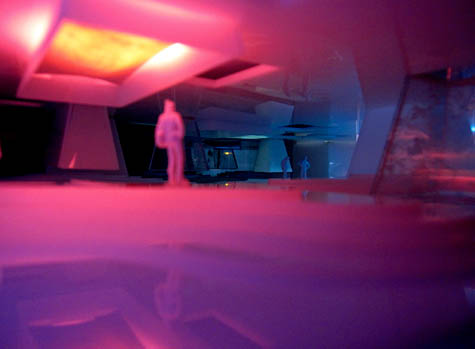 [Image: From "Change of Heart: Rethinking the Prescriptive Medical Environment" by Marina Nicollier].
4) [Image: From "Change of Heart: Rethinking the Prescriptive Medical Environment" by Marina Nicollier].
4) This brings to mind Marina Nicollier's final thesis project at Rice University, wherein she explored the medical effects of architectural design.
Part of her project dealt with the history of sanitarium architecture and, from there, the health implications of modern architecture. She wrote: Popular ideas about what constitutes a healthy environment gave rise to many of the components that became the formal trademarks of modernism – the flat roof was devised as a means to provide additional sunning surfaces for tubercular patients; while the deep verandas, wide private balconies, and covered corridors served as organizational tools to isolate contagious patients from the general staff. In other words, at its origins, modern architecture was a kind of medical prescription – not a pill you swallowed but an environment you surrounded yourself with.
Nicollier continues: Visits to these establishments were prescribed, as were the conditions and durations of the exposures themselves. Today, of course, there is ongoing research to determine how and to what extent environmental factors such as temperature, natural and artificial light, and sound affect our health, and despite there having been some interesting conclusions, it is still an area of research that requires more investigation and exploratory trials. This idea, of controlled exposure to specific architectural forms, makes the equation between built space and medical treatment explicit.
How, then, might we expand and re-apply this research to whole cities in an era of swine flu and SARS?
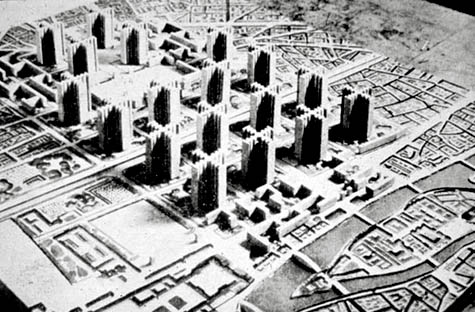 [Image: Le Corbusier's Plan Voisin for Paris].
5) [Image: Le Corbusier's Plan Voisin for Paris].
5) The medical aspects of utopia seem under-explored in contemporary urban literature. Here, utopia could be retheorized as the city where no one gets sick. Through microbe-resistant building materials and a precisely measured anti-contagious spatiality, perhaps, your metropolis might even cure you.
Utopia becomes a hospital ward the size and shape of a city.
Perhaps BLDGBLOG should sponsor a new urban design competition in which only medical doctors can participate. Design your vision of the healthy city, these doctors will be told; what urban forms will result?
Briefly, I'm reminded of BLDGBLOG's 2006 interview with Mike Davis. Referring, again, to his book Monster At Our Door and its exploration of biosecurity, I asked Davis: "What would a biosecure world actually look like, on the level of architecture and urban design? (...) Do you see any evidence that the medical profession is being architecturally empowered, so to speak, influencing the design of 'disease-free' public spaces?"
Davis replied that this was "exactly how Victorian social control over the slums was defined as a kind of hygienic project – or in the same way that urban segregation was justified in colonial cities as a problem of sanitation. Everywhere these discourses reinforce one another."
Further: Davis: Just as the Victorian middle classes could not escape the diseases of the slums, neither will the rich, bunkered down in their country clubs or inside gated communities. The whole obsession now is that avian flu will be brought into the country by –
BLDGBLOG: A Mexican!
Davis: Exactly: it’ll be smuggled over the border – which is absurd. This ongoing obsession with illegal immigration has become a one-stop phantasmagoria for… everything. Of course, it goes back to primal, ancient fears: the Irish brought typhoid, the Chinese brought plague. It’s old hat. The fact that this week's swine flu outbreak originated in Mexico seems doubly interesting in this context.
You can check out the interview for the rest of Davis's answer – but I still think the question of urban biosecurity deserves more architectural attention.
If the Centers for Disease Control could design a city, what would it look like? Could there be a medical equivalent of Baron Haussman or Robert Moses?
What is medical urban design?
 [Image: Robert Moses stands above a model of the city he would create; via Wikipedia].
6) [Image: Robert Moses stands above a model of the city he would create; via Wikipedia].
6) Producing a disease-free city, of course, requires the proper design tools.
Via Twitter (@ qimet888), I was pointed toward a demonstration program: Dynamical Network Design for Controlling Virus Spread.
The clunkily-named program "shows the dynamics of the spread of the SARS virus in Hong Kong's 18 districts when the optimal resources allocation is used." In the simulation, the color green represents an infection-free district, that is, one in which the number of infected people is smaller than one. For infected districts, shades of red are used to indicate the level of infection. Darker red means that there are more infected people in the region and lighter red means that fewer people are infected. The viewer can see that the virus is stopped very quickly using the optimal design: the regions quickly turn green regardless of the initial conditions. The implication seems clear: toggle your parameters – move people, buildings, walls, hospital wards, sewers, etc., around until you find the right combination – and your city itself might help to eradicate disease.
It would "stop the infectious vectors in their tracks," as Ballard wrote.
 [Image: Of SARS and the city: from Wolfram's Dynamical Network Design for Controlling Virus Spread].
7) [Image: Of SARS and the city: from Wolfram's Dynamical Network Design for Controlling Virus Spread].
7) Why not turn this into a game?
Design the ultimate disease-free city: SimCity: Dark Winter, Urban Outbreak, or even a biomedical version of Settlers of Catan. Your goal is to redesign a city in real-time in order to extinguish a burgeoning plague epidemic. Perhaps SOM could sponsor it – and own rights over the winning results – in an attempt to corner the market in infection-free city planning.
You could even reverse the game's moral order and require players to create the ideal city for disease transmission: whoever kills off their entire game's population in the shortest period of time wins. The all-time winner infects the world in less than a second.
8) All of this occurs as I've been reading Steven Johnson's book The Ghost Map. The book consistently raises the issue of public health as an urban design concern – and, at the risk of repeating myself here, it would seem like epidemiology should be a vital part of all city planning courses. Spatial epidemiology, in fact, seems so interesting, and so important, that I'm almost tempted to go back to school for it.
A great final thesis would be a series of test landscapes – epidemiological prototypes – in which hypothetical diseases run their course against a landscape of airlocks and plastic sheeting, chairs moved 18" further apart, walls erected where there once were screens, and sewers buried another three feet deeper underground. Pushed too far, one of the resulting landscapes becomes completely abiological, incapable of supporting life, sterilizing everything through the design of space alone.
In any case, Johnson's book is an impressively multi-scalar look at how apparently simple urban design decisions can produce very tragic effects in indirect arenas, elsewhere. Add to this demographic information about who lived where in London at the time, the economics of things like 19th-century water delivery, and the changing nature of medical treatment, and you get a fascinating look at how certain cities either cultivate or effectively stop the spread of diseases.
In the face of very real medical concerns, I might suggest that designing our cities according to historical expectations – let alone according to the spatial needs of the automotive industry – has never seemed quite so arbitrary.
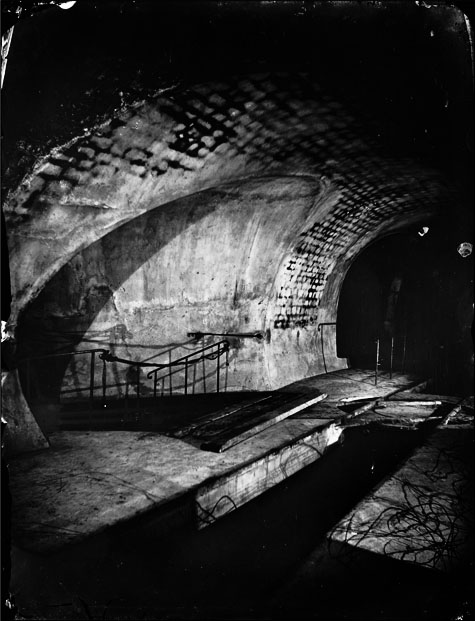 [Image: The sewers of Paris as photographed by Nadar; taken from an article by Matthew Gandy].
9) [Image: The sewers of Paris as photographed by Nadar; taken from an article by Matthew Gandy].
9) With apologies for a brief personal anecdote, I was in Paris for a week in the fall of 1997; having just read Foucault's Pendulum for the second and third times, respectively, earlier that summer – somewhat inexplicably, I've read that book nine times now – I decided to take a tour of the Paris sewer system.
My "tour group," such as it was, consisted solely of myself and another American backpacker, who had just finished reading The Coming Plague by Laurie Garrett a few nights before. Doing so apparently made him obsessed with cancer; it was the only thing he talked about.
As the two of us walked through the unbelievable stench of Parisian wastewater, watching used condoms float by and rats crawl away in the darkness ahead, and while we listened to the slightly bemused narration of our female tour guide, the backpacker began telling me about the possible viral nature of cancer, the incurability of certain forms of the disease, and the inevitability that most of us would, in the end, develop it.
Strolling around through fecally-contaminated vaults beneath the city, discussing the history of urban sanitation amidst unhinged speculations about the possibly infectious nature of certain types of cancer, I could joke that the tour's end didn't come fast enough, but I was fascinated.
Between experiential urban infrastructure, Victor Hugo's subterranean chase scene in Les Misérables, and an overwhelming desire to spray myself with deodorant, it nonetheless could have been the ideal setting for a walking salon, so to speak, a conversational meeting of the minds about disease and the city.
Call it The Dante Project™: get doctors from around the world together in Paris every year for a series of long strolls through the well-sewered underworld. Swine flu, cholera, H5N1, cancer, AIDS, ebola: never again will they be as viscerally reminded of what they've devoted their lives to cure.
10) In the end, then, what spatial form might a medical utopia take, and how could it be architecturally realized?
In 50 years will you be walking around the edges of the city with your grandkids when one of them asks: Why are these buildings out here, so far away from the rest?
And you'll say: They're here because of swine flu. We redesigned the city and our diseases went away.
 [Image: "I'm Spanish Moss!" Photo by Ian Aleksander Adams, from his series Gray Days]. [Image: "I'm Spanish Moss!" Photo by Ian Aleksander Adams, from his series Gray Days].
After reading BLDGBLOG's post last month about those peculiar moving landscapes known as ghillie suits, photographer Ian Aleksander Adams got in touch with a photograph he took last year.
"I remember running into someone last Halloween in Savannah, GA," Adams wrote. "I looked confused and he yelled 'I'm Spanish Moss!' and jumped into a tree – I was quick enough to get a shot, which ended up in my last book."
The photo, above, is part of Adams's series Gray Days.
(Thanks, Ian!)
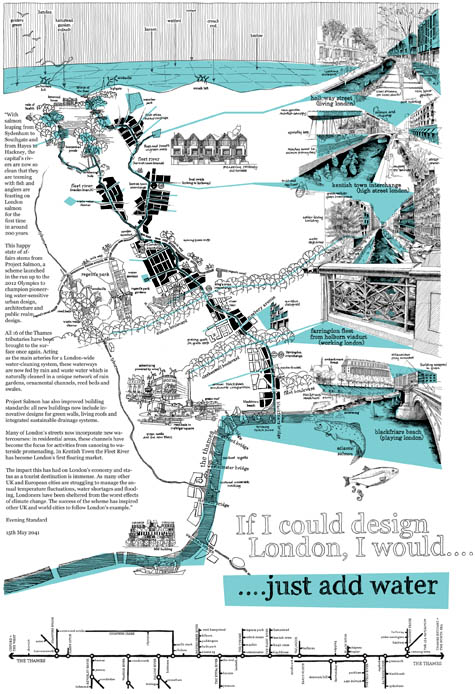 [Image: EDAW's "If I could design London, I would... just add water"; view larger!]. [Image: EDAW's "If I could design London, I would... just add water"; view larger!].Having been interested in the riverine nature of London for years now – not many people realize that it's a city of canals – when I stumbled on a poster produced by EDAW for an exhibition last summer called " If I could design London I would...," I was excited enough to print it out and pin it up on my wall here at BLDGBLOG Centraal. Now that I'm moving apartments – again – and have been forced to take the poster down, I decided I should actually write something about it. 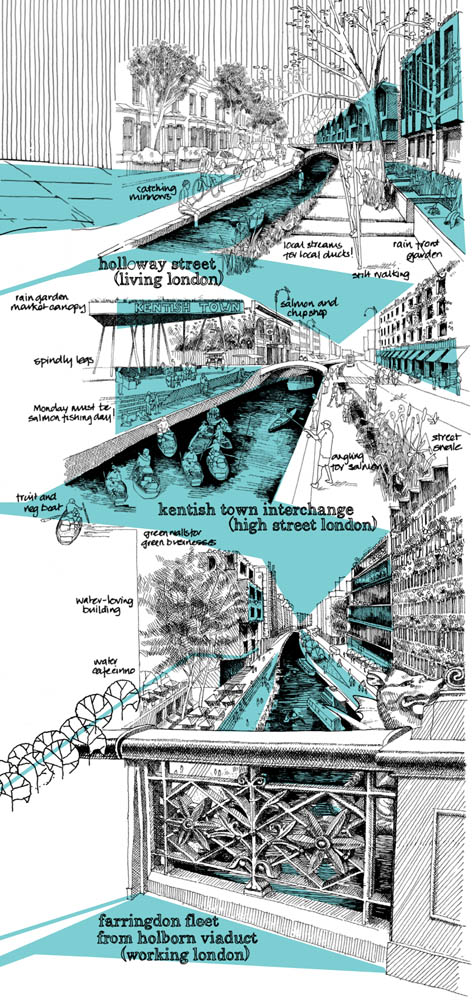 [Image: A close-up of EDAW's "If I could design London, I would... just add water"]. [Image: A close-up of EDAW's "If I could design London, I would... just add water"].Using the trope of a fake newspaper article – supposedly published in the Evening Standard in the year 2041 A.D. – EDAW, a surprisingly interesting firm, I might add, write the following scenario. I'll quote the whole thing, in fact, as I don't believe it's been published elsewhere online, and it's an interesting example of fictional narrative put in the service of urban design: With salmon leaping from Sydenham to Southgate and from Hayes to Hackey, the capital's rivers are now so clean that they are teeming with fish and anglers are feasting on London salmon for the first time in around 200 years.
This happy state of affairs stems from Project Salmon, a scheme launched in the run up to the 2012 Olympics to champion pioneering water-sensitive urban design, architecture and public realm design.
All 16 of the Thames tributaries have been brought to the surface once again. Acting as the main arteries for a London-wide water-cleaning system, these waterways are now fed by rain and waste water which is naturally cleaned in a unique network of rain gardens, ornamental channels, reed beds and swales.
Project Salmon has also improved building standards: all new buildings now include innovative designs for green walls, living roofs and integrated sustainable drainage systems.
Many of London's streets now incorporate new watercourses: in residential areas, these channels have become the focus for activities from canoeing to waterside promenading. In Kentish Town the Fleet River has become London's first floating market.
The impact this has had on London's economy and status as a tourist destination is immense. As many other UK and European cities are struggling to manage the annual temperature fluctuations, water shortage and flooding, Londoners have been sheltered from the worst effects of climate change. The success of the scheme has inspired other UK and world cities to follow London's example. The city's buried waterways are returned to the service; roads have becomes rivers; polluted byways are retrofitted into fishing grounds; former car parks find themselves walled off as reservoirs; canals have been reclaimed by the boats of floating markets; roundabouts are overgrown to form wetlands; and green roofs overlook it all. It's idyllic, sure, but it's no mere flight of fancy: the city is flooding, slowly but surely, over the course of coming centuries. Like it or not, in less time than now exists between us and Shakespeare, our descendants will be living in a London underwater: architects and urban designers – and, for that matter, novelists – might as well start planning now. EDAW's project, and nearly two dozen others, can still be downloaded, a year after the fact, from Building Design.
 [Image: A glimpse of Honda's brain-interface technology, otherwise unrelated to the post below]. [Image: A glimpse of Honda's brain-interface technology, otherwise unrelated to the post below].
Among many other interesting things in the highly recommended Wired for War: The Robotics Revolution and Conflict in the Twenty-First Century by P.W. Singer – a book of interest to historians, psychologists, designers, military planners, insurgents, peace advocates, AI researchers, filmmakers, novelists, future soldiers, legislators, and even theologians – is a very brief comment about military research into the treatment of paralysis.
In a short subsection called "All Jacked Up," Singer refers to "a young man from South Weymouth, Massachusetts," who was "paralyzed from the neck down in 2001." After nearly giving up hope for recovery, "a computer chip was implanted into his head." The goal was to isolate the signals leaving [his] brain whenever he thought about moving his arms or legs, even if the pathways to those limbs were now broken. The hope was that [his] intent to move could be enough; his brain's signals could be captured and translated into a computer's software code. None of this seemed like news to me; in fact, even the next step wasn't particularly surprising: they hooked him up to a computer mouse and then to a TV remote control, and the wounded man was thus able not only to surf the web but to watch HBO.
What I literally can't stop thinking about, though, was where this research "opens up some wild new possibilities for war," as Singer writes.
In other words: why hook this guy up to a remote control television when you could hook him up to a fully-armed drone aircraft flying above Afghanistan? He would simply pilot the plane with his thoughts.
 [Image: A squadron of drones awaits its orders]. [Image: A squadron of drones awaits its orders].
This vision – of paralyzed soldiers thinking unmanned planes through war – is both terrible and stunning.
Singer goes on to describe DARPA's " Brain-Interface Project," which helped pay for this research, in which training the paralyzed to control machines by thought could be put to use for military purposes.
Later, Singer describes research into advanced, often robotic prostheses; "these devices are also being wired directly into the patient's nerves," he writes. This allows the solder to control their artificial limbs via thought as well as have signals wired back into their peripheral nervous system. Their limbs might be robotic, but they can "feel" a temperature change or vibration. When this is put into the context of the rest of Singer's book – where we read, for instance, that "at least 45 percent of [the U.S. Air Force's] future large bomber fleet [will be] able to operate without humans aboard," with other "long-endurance" military drones soon "able to stay aloft for as long as five years," and if you consider that, as Singer writes, the Los Angeles Police Department "is already planning to use drones that would circle over certain high-crime neighborhoods, recording all that happens" – you get into some very heady terrain, indeed. After all, the idea that those drone aircraft circling over Los Angeles in the year 2013 are actually someone's else literal daydream simply blows me away.
In other words, if you can directly link the brain of a paralyzed soldier to a computer mouse – and then to a drone aircraft, and then perhaps to an entire fleet of armed drones circling over enemy territory – then surely you could also hook that brain up to, say, lawnmowers, remote-controlled tunneling machines, lunar landing modules, strip-mining equipment, and even 3D printers.
And here's where some incredible landscape design possibilities come in.
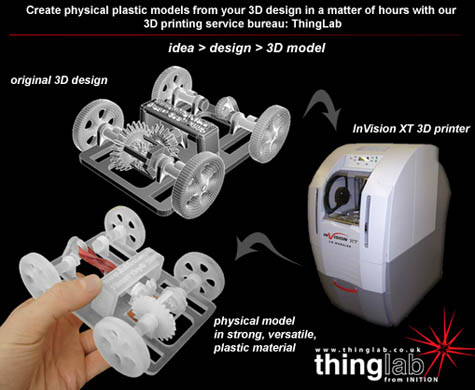 [Image: 3D printing, via Thinglab]. [Image: 3D printing, via Thinglab].
A patient somewhere in Gloucestershire dreams in plastic objects endlessly extruded from a 3D printer... Architectural models, machine parts, abstract sculpture – a whole new species of object is emitted, as if printing dreams in three-dimensions.
Or you go to a toy store in Manhattan – or to next year's Design Indaba, or to the Salone del Mobile – and you find nothing but rooms full of strange objects dreamed into existence by paralyzed 16-year olds.
The idea of brain-controlled wireless digging machines, in particular, just astonishes me; at night you dream of tunnels – because you are actually in control of tunneling equipment operating somewhere beneath the surface of the earth.
A South African platinum mine begins to diverge wildly from real sites of mineral wealth, its excavations more and more abstract as time goes on – carving M.C. Escher-like knots and strange cursive whorls through ancient reefwork below ground – and it's because the mining engineer, paralyzed in a car crash ten years ago and in control of the digging machines ever since, has become addicted to morphine.
Or perhaps this could even be used as a new and extremely avant-garde form of psychotherapy.
For instance, a billionaire in Los Angeles hooks his depressed teenage son up to Herrenknecht tunneling equipment which has been shipped, at fantastic expense, down to Antarctica. An unmappably complex labyrinth of subterranean voids is soon created; the boy literally acts out through tunnels. If rock is his paint, he is its Basquiat.
Instead of performing more traditional forms of Freudian analysis by interviewing the boy in person, a team of highly-specialized dream researchers is instead sent down into those artificial caverns, wearing North Face jackets and thick gloves, where they deduce human psychology from moments of curvature and angle of descent.
My dreams were a series of tunnels through Antarctica, the boy's future headstone reads.
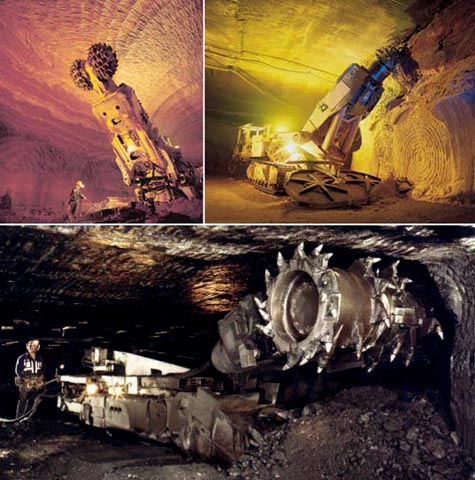 [Image: Three varieties of underground mining machine]. [Image: Three varieties of underground mining machine].
That, or we stay aboveground and we look at the design implications of brain-interfaced gardening equipment.
I'm imagining a new film directed by Alex Trevi, in which a landscape critic on commission from The New Yorker visits a sprawling estate house somewhere in southern France. The owner has been bed-bound for three decades now, following a near-fatal car accident, but his brain was recently interfaced directly with an armada of wireless gardening machines: constantly trimming, mowing, replanting, and pruning, the gardens outside are shifted with his every thought process.
Having arrived simply to write a thesis about this unique development in landscape design, our critic finds herself entranced by the hallucinatory goings-on, the creeping vines and insectile machines and moving walls of hedges all around her.
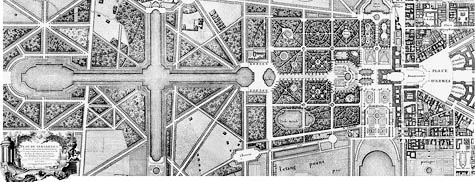 [Image: The gardens at Versailles, via Wikipedia]. [Image: The gardens at Versailles, via Wikipedia].
Returning to Singer, briefly, he writes that "Many robots are actually just vehicles that have been converted into unmanned systems" – so if we can robotize aircraft, digging machines, riding lawnmowers, and even heavy construction equipment, and if we can also directly interface the human brain to the controls of these now wireless robotic mechanisms, then the design possibilities seem limitless, surreal, and well worth exploring (albeit somewhat cautiously) in real life.
It could be a new episode of MythBusters, or the next iteration of the DARPA Grand Challenge. What's the challenge?
A paralyzed teenager has to dig a tunnel through the Alps using only his or her brain and a partial face excavation machine.
 [Image: Two examples of Indus script, from The Hindu].
Wired Science [Image: Two examples of Indus script, from The Hindu].
Wired Science today reports that Artificially Intelligent computers have at least partially cracked an otherwise unreadable, 4,000-year old language from the Indus Valley – which has at least me wondering if we haven't already entered into the world of Philip K. Dick: our archaeologists are actually software programs bringing dead languages back to life.
But something about the story also reminds me of Nina Burleigh's book Mirage, which I posted about last month, in which we read about Napoleon's invasion of Egypt.
Accompanying Napoleon's expeditionary force was a kind of secondary army of "savants": scientists, researchers, archaeologists, linguists, and other scholars who were there, ostensibly, to produce a scientific record of Nile civilization, but who, conveniently for Napoleon, also "offered moral cover for the invasion."
From Burleigh's introduction: When they first got to Egypt, the scientists tried to approach the land, people, animals, and relics not as tourists or literary travelers, or even colonizers, but from within their fields of scholarship. They categorized, measured, and collected, kept journals, and wrote reports that they read to one another at formal meetings in a recently vacated harem room. Set down and then abandoned in what was mostly a vast, uncharted desert, atheists surrounded by devout practitioners of a barely understood religion, encountering ruins that mutely testified to another equally unknown culture, they did not trust sense perception alone. They looked at and tried to explain what they saw by mathematically defining and classifying it. To make a long story short, Napoleon's scientists produced a massive and heavily illustrated catalog of Egyptian culture – you can actually buy an abridged version of it from Taschen – focusing on Pharaonic monuments and sand-covered ruins. However, the invasion also led to the discovery of the Rosetta Stone – and thus to the translation of ancient hieroglyphs.
In any case, what would the 21st-century equivalent of these savants be?
How interesting, I'd suggest, to imagine an army of Artificially Intelligent, wireless translation drones sent into the ruins of ancient temple complexes; they descend through otherwise inaccessible partly collapsed passages and domed vaults beneath hillsides in order to interpret the walls around them, narrating for the first time a vast and unfolding dream of gods and ancient earthquakes, their LEDs reflecting in colored glass mosaics on the floor.
Maybe they'd even use Twitter.
Think of it as WALL-E meets Champollion: a lonely machine installed somewhere in the darkness beneath the ruins of ancient India, hanging out with itself and telling myths of the birth of the universe, its feed syndicated live on blogs around the world.
With the caveat that this post doesn't have much to do with architecture, but with the further caveat that I will be speaking about media – specifically online media – next week at the Australian National Architecture Conference, I thought I'd offer a few thoughts here about Twitter.
 Inspired in this specific instance by Maureen Dowd's brain-dead editorial in yesterday's New York Times, but also by the obvious glee with which so many people have denigrated the note-taking value of Twitter, it seemed like time to address the subject. Ever since a friend of mine once claimed – very late and after many drinks – that "Twitter is the death of humanism," I've been regularly thinking about how a simple note-taking technology could inspire such apparent dread in so many people.
First, on the most obvious level, Twitter needs to be differentiated from what people write on Twitter. The fact that so many people now use Twitter as a public email system, or as a way to instant-message their friends in front of other people, is immaterial; Twitter is a note-taking technology, end of story. You take short-form notes with it, limited to 140 characters.
The clichéd analogy here has been with Japanese haiku, but perhaps we might even reference the Oulipo: in other words, Twitter means that you are writing, but you are writing within constraints.
Second, the comparison I often make here is with ball-point pens. Imagine a world where everyone uses typewriters: they write novels, manifestos, historical surveys, and so on, but they do it all using typewriters. Now the ball-point pen comes along. People use it to write down grocery lists and street addresses and recipes and love notes. What is this awful new technology? the literary users of typewriters say. Ball-point pens are the death of humanism.
Nevermind, of course, that you can use ball-point pens to write whatever you want: a novel, a screenplay, epic poems, religious prophecy, architectural theory, ransom notes. You can draw astronomical diagrams, sketch impossible machines for your Tuesday night art class, or even work on new patent applications for a hydrogen-powered automobile – it doesn't matter. You can draw penises on your coworker's paycheck stub.
It's a note-taking technology.
 Who cares if people use ball-point pens for writing down phone numbers and movie times, or even drawing little hearts on someone else's notebook in the middle of English class? It doesn't mean that they hate literature. Similarly, who cares if someone uses Twitter to say that they're bored, or to list what they ate last night? It doesn't mean the barbarians are at the gates.
This leads to a third point, which is that, according to Dowd's own absurd logic – she describes Twitter as something "for bored celebrities and high-school girls" – well, first of all, who says high-school girls aren't supposed to write? And why is it anyone else's business if a bored person, who happens also to be famous, decides to share random thoughts with the world?
However, what very much bothers me about this attitude toward Twitter is something else: if you were to go around the United States reading the handwritten diaries of, say, high-school girls or adolescent boys or even well-read college students, you would find equally inane chattering: "I feel fat today." "Can't wait for summer in Boca! But I need new shorts." "My history professor is HOT." "I hate holidays. Christmas at home is so boring."
Are you really going to tell me that the average contemporary, hand-written diary is any more interesting than that? In fact, one could easily argue that private, paper-based journals would be volumetrically much worse than Twitter in their sheer scale of self-obsession.
Yet the anti-Twitter crowd doesn't appear to oppose the use of personal journals during adolescence. For instance, will Dowd soon also be writing an editorial that excoriates lonely teenagers for writing down their thoughts on paper? After all, she bizarrely implies, "high-school girls" shouldn't be allowed access to new forms of writing technology, so she must have been apoplectic when cheap pens and affordable notebooks first arrived in the office supply store: suddenly anyone, even blonde girls, could be writers.  This strange and somewhat disturbing resistance to seeing other people writing was encapsulated quite well, I'd suggest, in a question submitted last month to ForYourArt, referring to the fact that people were using Twitter during Postopolis! LA.
A concerned reader wrote in: Can you please explain to me why people sitting next to each other twittering into cyberspace is SO much more important than sharing ideas with the people beside them??? Does twittering really expand, engage ideas and other opinions – or does it further isolate people from the communities right next to them??? The only way these questions would make any sense at all is if this person also hates people who use notebooks in public – indeed, if this person looks down upon public note-taking of any kind. Does she also have a problem with someone taking photographs – or producing other, non-textual forms of event documentation – or is there just something particularly inexcusable about the desire to make textual records of a live event?
If I attend a public lecture but I start to jot things down in a Moleskine, it would seem that only a particularly virulent form of social fascism would ask me to put that notebook down and begin "sharing ideas" with the people next to me.
No thanks – I'd rather write, actually.
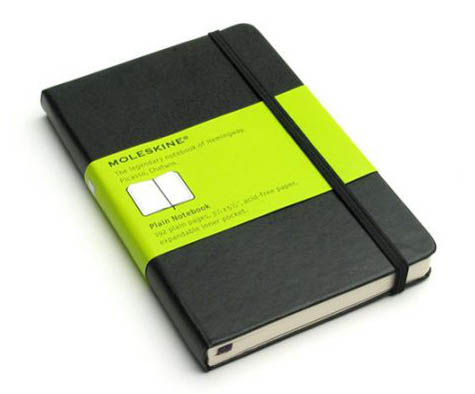 Again, I fail to see any clear distinction between someone's boring Twitter feed – considered only semi-literate and very much bad – and someone else's equally boring, paper-based diary – considered both pro-humanist and unquestionably good.
Kafka would have had a Twitter feed! And so would have Hemingway, and so would have Virgil, and so would have Sappho. It's a tool for writing. Heraclitus would have had a f***ing Twitter feed.
Finally, and perhaps most importantly of all, now that the other half writes – all the jocks and high-school girls and video store employees and D-list celebrities – it seems comparable only to a kind of police action that the people who once thought they were the chosen writers, that they were this generation's idea-smiths, are now so up in arms.
Those other people – those everyday people who weren't supposed to have thoughts, who aren't known for reading David Foster Wallace or Dostoevsky or James Joyce, those overlooked people from whom we buy groceries, who fix our cars, clean our houses, and vote differently than we do – weren't supposed to become writers.
Now that suburban housewives in Missouri are letting their thoughts be known via Twitter, it's as if writing itself is thought to be under attack, invaded from all sides by the unwashed masses whose thoughts have not been sanctioned as Literature™.
In many ways, I'm reminded of Truman Capote's infamous put-down of Jack Kerouac: "That's not writing, it's typing."
So there seem to be quite a lot of assumptions at work here, with so many class, political, and even gender implications for who is allowed to speak, who we are meant to listen to, who can write, how they are permitted to do so, in what social contexts writing is meant to occur, and what topics can be legitimately addressed by others, that I'd hope a much longer discussion about this might someday take place. Until then, we get Maureen Dowd.
So Twitter is very obviously not the answer to everything, and it never should have been portrayed that way; but it also very obviously is not the death of humanism.
Twitter is just another option for people to use when they want to take notes – and it's no more exciting than that, either, to be frank. It's a ball-point pen.
Get over it.
While packing up the apartment here and getting ready not only for another move but for an impending flight to Melbourne, I keep stumbling upon interesting old news clippings, quotations, and articles that I've saved, printed out, or otherwise written down in a notebook somewhere.
This afternoon, for instance, it was a short piece from New Scientist, originally published back in September 2008.
 [Image: The Cepheid Variable RS Pup]. [Image: The Cepheid Variable RS Pup].
Apparently, all those stars out there might be something more than mere heavenly bodies.
That is, "the galactic equivalent of the internet," if there is such a thing, might take the form of manipulated stars. What kind of stars? Cepheid variables, or "stars that vary regularly in brightness."
This regular dimming and brightening could be used as a way both to encode and broadcast information.
From the article: Crucially, these "Cepheid variables" are so luminous they can be seen as far away as 60 million light years. Jolting the star with a kick of energy – possibly by shooting it with a beam of high-energy particles called neutrinos – could advance the pulsation by causing its core to heat up and expand, [some scientists] say. That could shorten its brightness cycle – just as an electric stimulus to a human heart at the right time can advance a heartbeat. The normal and shortened cycles could be used to encode binary "0"s and "1"s. The implication here is that hundreds of stars might already be "a galaxy-spanning internet" put into service by intelligent, nonhuman species.
The print version of the article differs a bit from the online one, and I'm quoting the print version here: "There are over 500 cepheids in the Milky Way, and countless more in nearby galaxies, so data could be shuffled around as in a computer network."
Overlooking some of the more basic questions here – such as why on earth is this kind of cannabinoid speculation being printed in a science magazine? – the idea that information is being relayed back and forth, from star to star, as if inside some vast celestial harddrive, raised at least my eyebrows.
What messages, or fragments of messages, might we be witnessing every night? And if there are no messages, yet we transcribe those flickering astral patterns nonetheless, what unexpected literatures of deep space might we think we've been translating?
(Earlier on BLDGBLOG: Planet Harddrive).
Someone hooks a building's mechanical systems up to Twitter so that it can tell people things about itself – like when to expect the next elevator, at what point certain lightbulbs need to be replaced, which floors need mopping, and what its general maintenance schedule might be.
But, instead, it goes AI on the world.
It starts to complain about unappreciative guests and loud neighbors; it wistfully remembers former residents from years gone by. There was that rainy afternoon last summer, it writes, when that woman from the fourth floor got on an elevator...
It tweets at midnight, and at 2am, and as people come and go for lunch. It gets lonely. It makes things up sometimes; people laugh and re-tweet it.
It's just a dumb little building somewhere in an overlooked city in America – but it has thoughts. And soon it wins the Pulitzer Prize.
 [Image: Photo by Jonathan Brown. Brown reviewed the launch on his blog, Around Britain with a Paunch, writing that he and his friends "mingled in the mist, like shadows on the set of Hamlet"].
Note: This is a guest post by Nicola Twilley. [Image: Photo by Jonathan Brown. Brown reviewed the launch on his blog, Around Britain with a Paunch, writing that he and his friends "mingled in the mist, like shadows on the set of Hamlet"].
Note: This is a guest post by Nicola Twilley.
A former boutique storefront in London has become the temporary home for a pop-up bar with a twist: 2 Ganton Street is currently the U.K.'s "first walk in cocktail." Created by Bompas & Parr (known for their earlier experiments with glow-in-the-dark jello and scratch & sniff cinema), the "Alcoholic Architecture" bar features giant limes, over-sized straws, and most importantly, a gin-and-tonic mist.
Lucky ticket-holders (the event has now sold out) are equipped with plastic jumpsuits and encouraged to "breathe responsibly" before stepping into an alcoholic fog for up to 40 minutes – long enough to inhale "a fairly strong drink," according to Wired UK.
The Guardian noted that "as far as taste goes, this is the real deal," with some mouthfuls of air "sweeter with tonic and others nicely gin-heavy." Sam Bompas explained to Wired that they chose to vaporize gin and tonic (rather than, say, an appletini) because of its "nice smell, botanical flavours and freshness." St. John Ambulance volunteers are on hand, though the only reported casualties so far seem to have been hairstyles – victims of "gin-frizz". The Guardian concluded that, "With no sentient ice cubes able to confirm it, one can only assume that this is what the inside of a G and T feels like."
 [Image: Antony Gormley's Blind Light, 2007, courtesy of the artist and Jay Jopling/White Cube, London, ©Stephen White]. [Image: Antony Gormley's Blind Light, 2007, courtesy of the artist and Jay Jopling/White Cube, London, ©Stephen White].
The project was inspired by Antony Gormley's Blind Light, a fog box installed at the Hayward Gallery in 2007. Bompas & Parr, who describe their world as operating in "the space between food and architecture," worked with the same company, JS Humidifiers, to adapt and install the ultrasonic humidifiers that create the thick, gin-based fog.
Though even typing "thick, gin-based fog" makes me feel a bit queasy, the experiment does seem to provide a perfect instantiation of London's social history, the city's prevailing damp, and its dense population. If the project is recreated elsewhere, perhaps local conditions will shape the installation: a freezing hail of neat vodka will form a layer of crystals on fur hoods and boots at a cavernous underground bar in Moscow; or a refreshing rum-and-coke mist will cool sunburned spring-breakers in the overcrowded hotel rooms of Daytona Beach.
 [Image: JS Humidifiers]. [Image: JS Humidifiers].
Of course, the architectural manipulation of humidity is not limited to alcohol. As JS's website boasts: "For precise control of humidity and temperature, extreme outputs, specialist construction for controlled environments or unusual control, whatever the requirement JS will design and manufacture a solution." Existing clients for these bespoke humidification systems apparently include medical device manufacturing, offshore oil exploration, firearms production, specialist printing, pharmaceutical production and automotive manufacturing. It seems clear that custom atmosphere solutions are a product with endless applications: migrating from industry to art to retail, with the next step being high-end custom interior design for the very rich.
It can only be a matter of time before wealthy individuals are able to wake up to vaporized coffee, maintaining their multi-tasking edge by inhaling caffeine for that last half-hour of sleep, while the riders of Hollywood stars will routinely specify custom dressing rooms bathed in a fine mist of light-diffusing, age-defying elixirs.
[Earlier posts by Nicola Twilley include Park Stories, Park's Parks, Dark Sky Park and Zones of Exclusion].
For an ambitious landscape design project, Magnus Larsson, a student at the Architectural Association in London, has proposed a 6,000km-long wall of artificially solidified sandstone architecture that would span the Sahara Desert, east to west, offering a combination of refugee housing and a "green wall" against the future spread of the desert. 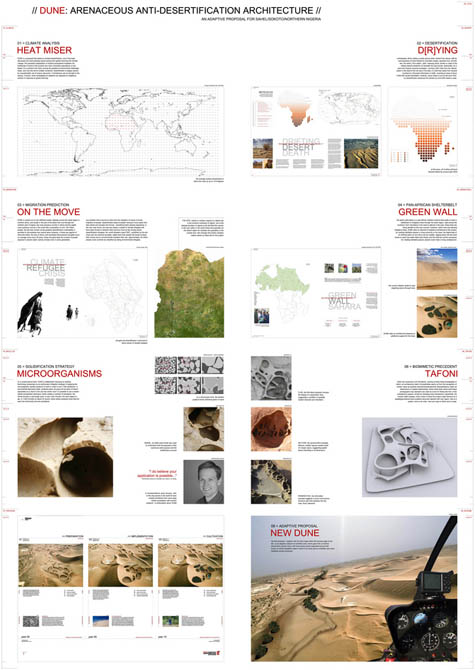 [Image: From Magnus Larsson's Dune: Arenaceous Anti-Desertification Architecture]. [Image: From Magnus Larsson's Dune: Arenaceous Anti-Desertification Architecture].Larsson's project deservedly won first prize last fall at the Holcim Foundation's Awards for Sustainable Construction held in Marrakech, Morocco. One of the most interesting aspects of the project, I think, is that this solidified dunescape is created through a particularly novel form of "sustainable construction" – that is, through a kind of infection of the earth. In other words, Larsson has proposed using bacillus pasteurii, a "microorganism, readily available in marshes and wetlands, [that] solidifies loose sand into sandstone," he explains.  [Image: From Magnus Larsson's Dune: Arenaceous Anti-Desertification Architecture]. [Image: From Magnus Larsson's Dune: Arenaceous Anti-Desertification Architecture].Larsson points out the work of the Soil Interactions Lab at UC-Davis, which describes itself as " harnessing microbial activity to solidify problem soils." But the idea of taking this research and applying it on a megascale – that is, to a 6,000km stretch of the Sahara Desert – boggles the mind. At the very least, the idea that this might be deployed for the wrong reasons, or by the wrong people, in some delirious hybrid of ice-nine, J.G. Ballard's The Crystal World, and perhaps a Roger Moore-era James Bond film, deserves further thought. An epidemic of bacillus pasteurii infects all the loose sand in the world, forming great aerodynamic fins and waves in a kind of global Utah of glassine shapes. 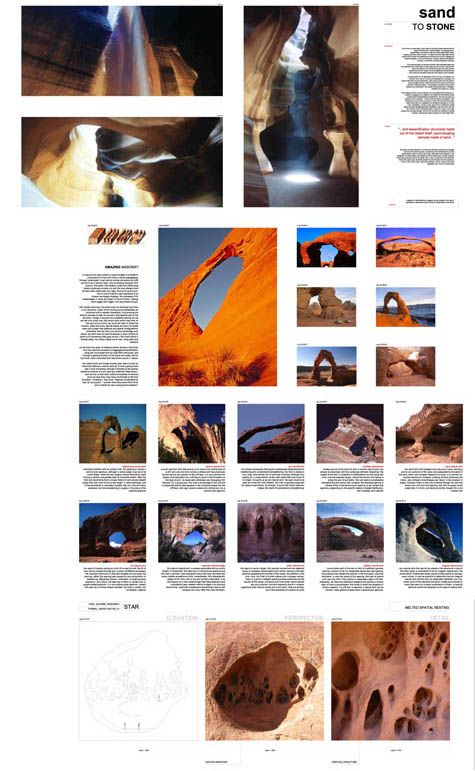 [Images: From Magnus Larsson's Dune: Arenaceous Anti-Desertification Architecture]. [Images: From Magnus Larsson's Dune: Arenaceous Anti-Desertification Architecture].Clarifying the biochemical process through which his project could be realized, Larsson explained in a series of emails that his "structure is made straight from the dunescape by flushing a particular bacteria through the loose sand... which causes a biological reaction whereby the sand turns into sandstone; the initial reactions are finished within 24 hours, though it would take about a week to saturate the sand enough to make the structure habitable." The project – a kind of bio-architectural test-landscape – would thus "go from a balloon-like pneumatic structure filled with bacillus pasteurii, which would then be released into the sand and allowed to solidify the same into a permacultural architecture." 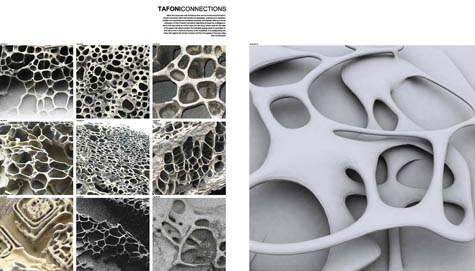 [Image: From Magnus Larsson's Dune: Arenaceous Anti-Desertification Architecture]. [Image: From Magnus Larsson's Dune: Arenaceous Anti-Desertification Architecture].The "architectural form" of the resulting solidified sandscape is actually "derived from tafoni," Larsson writes, where tafoni is "a cavernous rock structure that formally ties the project back to notions of aggregation and erosion. On a conceptual scale, the project spans some 6,000km, putting it on a par with Superstudio's famous Continuous Monument – but with an environmental agenda." 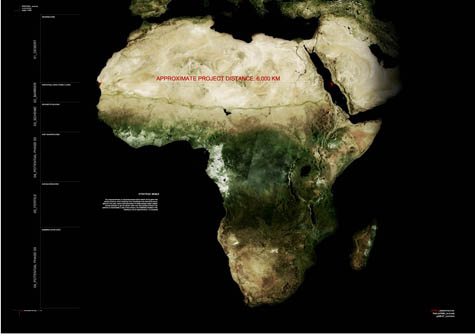 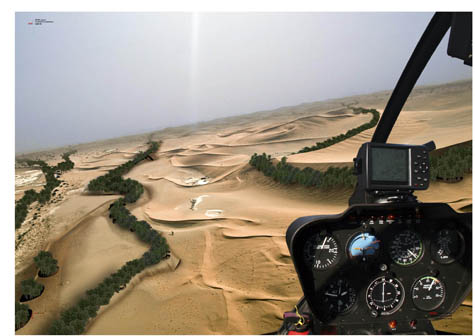 [Images: From Magnus Larsson's Dune: Arenaceous Anti-Desertification Architecture]. [Images: From Magnus Larsson's Dune: Arenaceous Anti-Desertification Architecture].I'm reminded of Michael Welland's recent book Sand. There, Welland describes "how deserts operate" (he compares them to "engines" of mechanical weathering); he points out that you can still find "sand-sized fragments of steel" on the D-Day beaches of Normandy, war having left behind a hidden desert of metal; and he mentions that the UK now maintains "the world's first database of sand" – but that it's used "specifically for police forensics." Welland's descriptions of sand dune physics are particularly memorable. He writes, for instance, that an avalanche is really a sand dune being "overwhelmed by the huge number of very small events" on its surface, and that these "very small events" unpredictably lead to one decisive moment of cascading self-collapse. 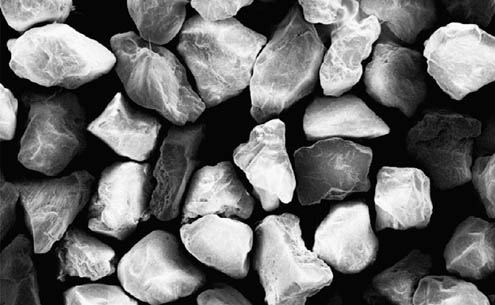 [Image: A photomicrograph of sand grains]. [Image: A photomicrograph of sand grains].Fantastically, though, and more relevant to this post, he then compares the internal structure of sand dunes to Gothic cathedrals: the grains of sand piled high form "microscopic chains and networks... in such a way that they carry most of the pressure from the weight of the material above them." This is the architecture of sand: These chains seem to behave like the soaring arches of Gothic cathedrals, which serve to transmit the weight of the roof, perhaps a great dome, outward to the walls, which bear the load. Briefly, though, this image can be sustained through Welland's descriptions of the great ergs, or sand seas, of today. These dune seas "are tangibly mobile, ever changing," Welland writes, "but there are larger areas of ergs past that are now fixed by vegetation." Most of today's active sandy deserts are surrounded by vast stretches of old stabilized dunes, formed as the trade-wind belts and arid regions expanded in the cold, dry climate of the last ice age and immobilized as the climate changed. However, continuing shifts in the climate may bring these fixed ergs, granular reserves awaiting activation, back to life. He mentions the Sand Hills of northwestern Nebraska, "formed originally from the debris of the glacial erosion of the Rocky Mountains." The hills were stabilized eight hundred years ago but have had episodes of reincarnation since: a long drought toward the end of the eighteenth century resuscitated dunes on the Great Plains, whose activity caused problems for the westbound wagon trains decades earlier. But if sand dunes are Gothic cathedrals, and if those dunes can come back to life, the resulting image of resuscitated Gothic cathedrals moving slowly over the American landscape is almost too incredible to contemplate.  [Images: From Magnus Larsson's Dune: Arenaceous Anti-Desertification Architecture]. [Images: From Magnus Larsson's Dune: Arenaceous Anti-Desertification Architecture].Larsson's project descriptions maintain this somewhat hallucinatory feel: I researched different types of construction methods involving pile systems and realised that injection piles could probably be used to get the bacteria down into the sand – a procedure that would be analogous to using an oversized 3D printer, solidifying parts of the dune as needed. The piles would be pushed through the dune surface and a first layer of bacteria spread out, solidifying an initial surface within the dune. They would then be pulled up, creating almost any conceivable (structurally sound) surface along their way, with the loose sand acting as a jig before being excavated to create the necessary voids. If we allow ourselves to dream, we could even fantasise about ways in which the wind could do a lot of this work for us: solidifying parts of the surface to force the grains of sand to align in certain patterns, certain shapes, having the wind blow out our voids, creating a structure that would change and change again over the course of a decade, a century, a millenium. A vast 3D printer made of bacteria crawls undetectably through the deserts of the world, printing new landscapes into existence over the course of 10,000 years... 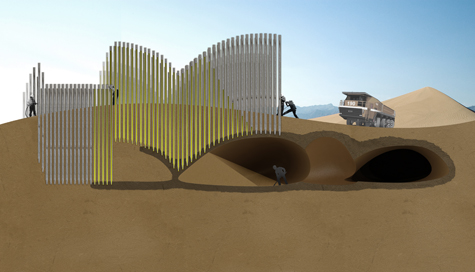 [Image: From Magnus Larsson's Dune: Arenaceous Anti-Desertification Architecture]. [Image: From Magnus Larsson's Dune: Arenaceous Anti-Desertification Architecture].Larsson goes on to contrast his method with existing vernacular techniques of anti-desertification: Traditional anti-desertification methods include the planting of trees and cacti, the cultivation of grasses and shrubs, and the construction of sand-catching fences and walls. More ambitious projects have ventured into the development of agriculture and livestock, water conservation, soil management, forestry, sustainable energy, improved land use, wildlife protection, poverty alleviation, and so on. This project, apart from utilising a completely new way of turning sand into sandstone, incorporates all of the above. Inside the dunes, we can take care of our plants and animals, find water and shade, help the soil remain fertile, care for the trees, and so on. In this way, it's an environmental project that hopefully provides an innovation for other architects/builders to use and copy time and time again. The following images show us the lab-based biochemical practices through which a landscape can be lithified. However, for me at least, these photos also come with the interesting implication that rogue basement chemists of the future won't be like Albert Hofmann or Ann & Alexander Shulgin; the heavily regulated underground rogue chemistry sets of the 21st century will instead synthesize new terrestrial compounds, counter-earths and other illegal geosimulants, rare earth anti-elements that might then catalyze a wholesale resurfacing of the world through radical landscape architecture. Which leads me to ask: where is landscape architecture's Aleister Crowley, Madame Blavatsky, or even John Dee? Mystics of terrestrial form, hacking the periodic table of the elements inside makeshift labs. 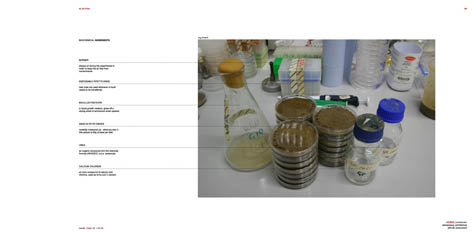 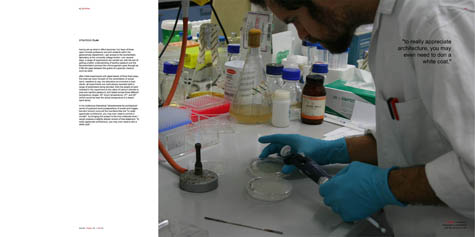 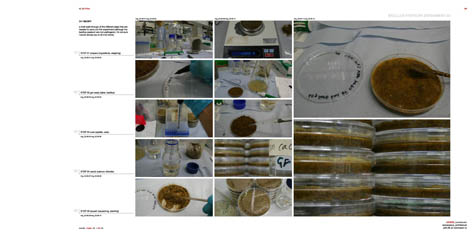 [Images: Synthesizing rare earth compounds – bioterrestriality; from Magnus Larsson's Dune: Arenaceous Anti-Desertification Architecture]. [Images: Synthesizing rare earth compounds – bioterrestriality; from Magnus Larsson's Dune: Arenaceous Anti-Desertification Architecture].In any case, Larsson's "solidified dunes," we read, would also "support the existing Green Wall Sahara initiative: 24 African countries coming together to plant a shelterbelt of trees right across the continent, from Mauritania in the west to Djibouti in the east, in order to mitigate against the encroaching desert."  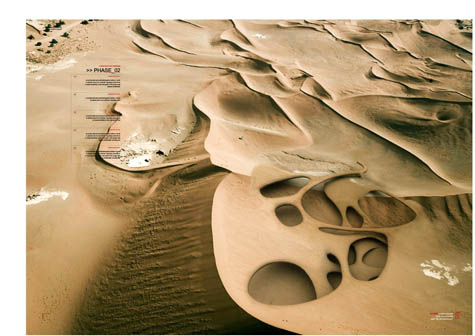  [Images: From Magnus Larsson's Dune: Arenaceous Anti-Desertification Architecture]. [Images: From Magnus Larsson's Dune: Arenaceous Anti-Desertification Architecture].Clearly having thought through the project in extraordinary detail, Larsson then points out that the structure itself would generate a "temperature difference between the interior of the solidified dunes and the exterior dune surface." This then "makes it possible to start building a permacultural network, the nodal points of which would support water harvesting and thermal comfort zones that can be inhabited."  [Image: The view from within; from Magnus Larsson's Dune: Arenaceous Anti-Desertification Architecture]. [Image: The view from within; from Magnus Larsson's Dune: Arenaceous Anti-Desertification Architecture].Eventually, then, a 6000km-long wall of permaculturally active, inhabited architecture will span the Sahara. Check out more images in this Flickr set for the project, or read a bit more about the project over at the Holcim Foundation.
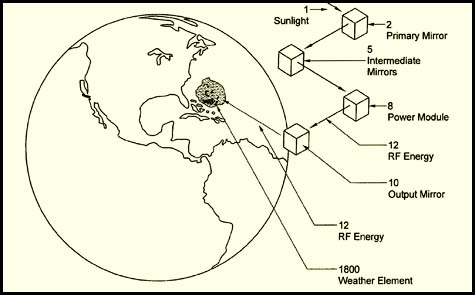 [Image: From a February 2006 patent application by SolarEn, proposing that terrestrial weather systems might be controlled by mirrors in space]. [Image: From a February 2006 patent application by SolarEn, proposing that terrestrial weather systems might be controlled by mirrors in space].It was reported yesterday that a California solar energy firm – SolarEn – hopes soon to construct " orbiting solar farms" that will harvest electricity in space. Each "farm" would be "a set of solar panels in outer space that would beam enough clean energy back to Earth to power half a million homes and could one day potentially help save the planet," according to the Guardian. SolarEn's specific plans are to put "an array of solar panels around 22,000 miles above the earth's equator using existing rocket technology, and then convert the power generated into radio-frequency transmissions. The radio waves would be beamed back down to antennae in Fresno, California and then converted into electricity and fed into the regular power grid." The images you see here, however, are from a patent application SolarEn filed back in February 2006, with quite a different purpose in mind. 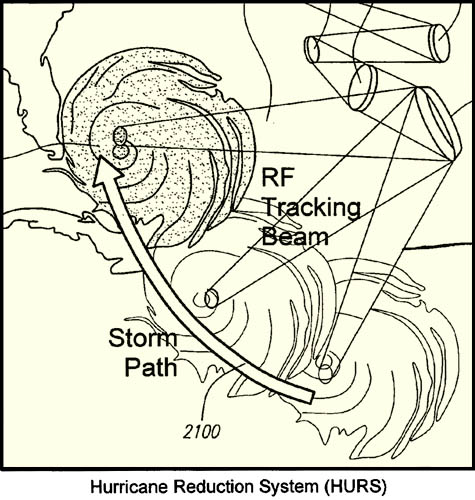  [Images: From SolarEn's February 2006 patent application]. [Images: From SolarEn's February 2006 patent application].Using a complicated geometry of spaceborne mirrors – seen in the diagrams below – in tandem with meteorological tracking technology, this device would give SolarEn the ability to control the weather. Or, as the patent application itself explains, it would be a "Space-based power system and method of altering weather using space-born energy": Power system elements are launched into orbit, and the free-floating power system elements are maintained in proper relative alignment, e.g., position, orientation, and shape, using a control system. Energy from the space-based power system is applied to a weather element, such as a hurricane, and alters the weather element to weaken or dissipate the weather element. The weather element can be altered by changing a temperature of a section of a weather element, such as the eye of a hurricane, changing airflows, or changing a path of the weather element. Weather control has become a topic of near-constant interest for me. As I suggested the other night in my talk at the SVA – and as I also explore in The BLDGBLOG Book – weather control could very well be the future of urban design; in other words, cities might very realistically attempt to engineer specialty microclimates – similar to Beijing's Olympic efforts at weather control last summer – as a new means of attracting new residents and future development. What's fascinating about SolarEn's proposal is that it seems entirely possibly that, for instance, Dubai, attempting to recapture the international imagination, might put into orbit a private, geostationary solar farm with which that city could not only power its delirious experiments in beach refrigeration and large-scale air-conditioning, but actually create a new climate for the city. 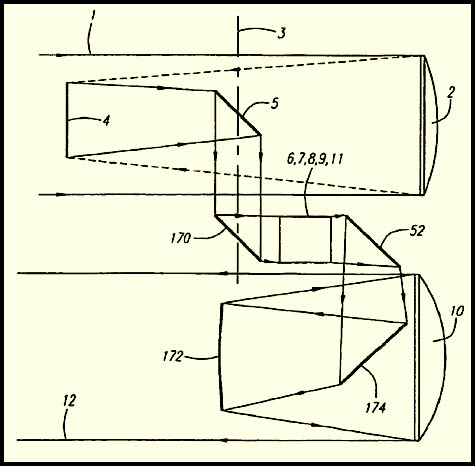 [Image: A geometry of mirrors in space, from SolarEn's February 2006 patent application]. [Image: A geometry of mirrors in space, from SolarEn's February 2006 patent application].That, of course, or it's just Real Genius all over again: after all, why use this technology only for stopping hurricanes when you could melt an opposing army's tanks or even assassinate someone through a brief application of solar overload? We'll just militarize Apollo, bringing astronomical power down upon our enemies, causing storms of fire in distant cities, evaporating reservoirs, and turning glaciers into roaring torrents of weaponized floodwaters. 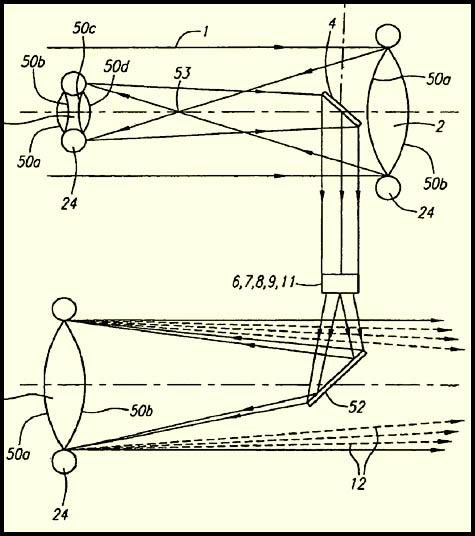 [Image: From SolarEn's February 2006 patent application]. [Image: From SolarEn's February 2006 patent application].In an endlessly fascinating article published two years ago in The Wilson Quarterly, historian James R. Fleming describes – among many other things – how a "weather race with the Russians" was fought on the level of climatological R&D between the U.S. and U.S.S.R. during the Cold War. For instance, "In the 1940s," Fleming writes, "General George C. Kenney, commander of the Strategic Air Command, declared, 'The nation which first learns to plot the paths of air masses accurately and learns to control the time and place of precipitation will dominate the globe.'" Indeed, the U.S. military ultimately hoped that it might learn how to "alter the global climate for strategic purposes," something which not only involved "using weather as a weapon of warfare," but "using controlled precipitation as a delivery system for biological and radiological agents." You could snow anthrax, say, onto the streets of belligerent cities unaware of the infections drifting down from above. But perhaps all they need is a strange new constellation of mirrors – a remote-controlled blur of light that moves against the stars it's surrounded by – to hurl typhoons against China or destroy a whole civilization's agricultural base from above. Toward the end of his article, Fleming asks: Assume, for just a moment, that climate control were technically possible. Who would be given the authority to manage it? Who would have the wisdom to dispense drought, severe winters, or the effects of storms to some so that the rest of the planet could prosper? At what cost, economically, aesthetically, and in our moral relationship to nature, would we manipulate the climate? Of course, having said all that, I don't mean to imply that SolarEn's weather control system is some kind of paranoiac Doomsday Device; but anyone who learns to stop – or, more to the point, conjure up – hurricanes from space will nonetheless be sitting on an unimaginably powerful technology. (Via Alexis Madrigal – who signed a contract for his first book yesterday. Congrats, Alexis!)
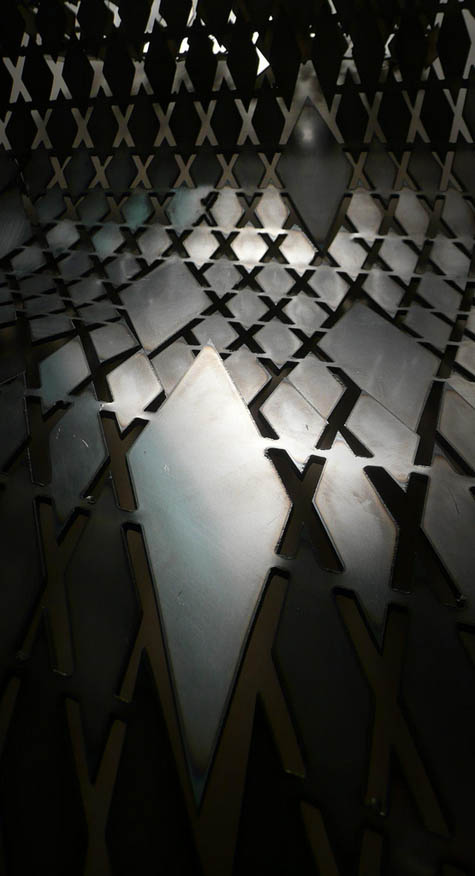 [Image: An absurdly beautiful photo of laser-cut steel by Elijah Porter, a student at the Yale School of Architecture]. [Image: An absurdly beautiful photo of laser-cut steel by Elijah Porter, a student at the Yale School of Architecture].Elijah Porter, a student at the Yale School of Architecture, has a great Flickr set up called Material Formation in Design. It features several awesome examples of how strategic cutting can transform a solid surface into a porous structure. In the specific case of the image featured above, you're looking at what might be called subtractive origami, wherein diamond-shaped cuts have introduced foldability and mesh into a solid sheet of steel. How interesting to think that, with just the right geometry of cuts and slices, you could activate the otherwise overlooked – or even unknown – baroque possibilities of a given material. You could even hold annual slice-design competitions, where students and mathematicians from around the world get together to display their secrets of cutting; one at a time, they program precise geometries into a laser-cutting machine, and whoever thereby achieves the most complex form, or the largest volume of folded space, wins. Huge, 8' x 8' sheets of steel are turned into spheres and waveforms, in a kind of arabesque of wounding through which metal becomes lace. One year, a student from Amsterdam blows everyone away by introducing just one, incredibly complex cut... and the whole sheet rolls up to the size of a one-inch ball. Or you obtain a truck-mounted laser and a grant from the Graham Foundation, and you proceed to cut a new, gridded faultwork into the bedrock of the continent – perforation on the scale of whole landscapes – so that the geography you're standing on simply folds up and disappears. Check out the rest of Porter's Flickr set here.
I was on pins and needles all morning knowing that my doorbell would ring, that there would be a bicycle courier standing there waiting for me – and that he or she would then hand me my very first copy of The BLDGBLOG Book. And it arrived! It's real, it's in my hands – and it looks fantastic.  [Image: The BLDGBLOG Book, published by Chronicle Books, designed by MacFadden & Thorpe, and illustrated by Brendan Callahan. Visible here are images by Joe Alterio, Alex Dragulescu, Sir Peter Cook/Archigram, Lateral Architecture, Michael Cook, Stanley Greenberg, Alexis Tjian, myself, Joel Sanders, Örvar Atli Þorgeirsson, NOAA et al., Lebbeus Woods, NASA et al., Ron Blakey, the USGS, David Maisel, and Brendan Callahan]. [Image: The BLDGBLOG Book, published by Chronicle Books, designed by MacFadden & Thorpe, and illustrated by Brendan Callahan. Visible here are images by Joe Alterio, Alex Dragulescu, Sir Peter Cook/Archigram, Lateral Architecture, Michael Cook, Stanley Greenberg, Alexis Tjian, myself, Joel Sanders, Örvar Atli Þorgeirsson, NOAA et al., Lebbeus Woods, NASA et al., Ron Blakey, the USGS, David Maisel, and Brendan Callahan].So amazing to see this thing in real life! From a series of Microsoft Word documents, to an ever-changing suite of PDFs, to a year and a half of long, long nights editing more than 125,000 words' worth of content, it's now bound, inked, and sitting here looking around at the world it tried to describe. And there's so much to say about it, I don't even really know where to begin. It's got five major chapters and a huge bibliography; it's got interviews, full-color photo spreads (by Simon Norfolk! David Maisel! Edward Burtynsky! Ilkka Halso! Bas Princen! and more!), as well as original illustrations by my colleague at Dwell, Brendan Callahan; it's got maps and plans and architectural sections; it's got renderings; it's got 19th-century British ruin paintings, W.G. Sebald, and J.G. Ballard; it's got FAT, geology, and rogue tunneling machines; it's got urban farming, icebergs, archaeology, and Archigram; it's got a saddle-stitched paperback binding that can open up flat, as well as multi-colored paper and an awesome use of a changing page grid; it's got two original comic strips by BLDGBLOG (my first!), drawn by Joe Alterio and printed on the inside covers; it's got runaway climate change, undersea cathedrals, artificial reefs, lost cities, oceangoing utopias, and the Chinese Olympics; it's got injected landforms, spray-foam monuments to the nuclear power industry, Gustave Doré's black and white visions of the underworld, and the architecture of Gothic horror; it's got blimps, retractable villages on the British coast, the San Andreas Fault, underground warfare in the mountains of Afghanistan, and a short interview with Alex Trevi (among so many other interviews! dozens! from Sir Peter Cook, Sam Jacob, and DJ /rupture to Lebbeus Woods and Mary Beard); it's got exploding stars, simulated mountain ranges on Venus, Mars habitats, and a quantum tomb for Albert Einstein; it's got Minsuk Cho, China Miéville, Christopher Wren, Frederick the Great, and Paradise Lost. Man, I'm so excited and so genuinely pleased to see this thing in person after such an incredibly long time putting it together. Check out some spreads here – and feel free to order the living crap out of this thing on Amazon.com, Amazon.ca, and Amazon.co.uk, or simply go straight to the source and pick up a copy through Chronicle Books themselves. Also, how incredibly interesting is it for me to see, on Amazon.com, which books customers "also bought," from Eyal Weizman to 306090 and Neal Stephenson. It's good company to be in! So expect more information about the book over the next two months, including voluminous and genuine thank yous for all the people who helped put it together – from my editor, Alan Rapp, and my designers, MacFadden & Thorpe, to everyone who contributed the book's eye-popping range of 300+ images – as the actual publication date approaches. But, for now, I just couldn't let today go without mentioning how happy I am to see this thing. Hello, book.
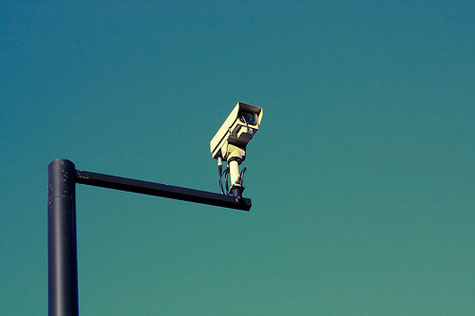 [Image: CCTV by (or perhaps via?) Charbel Akhras; check out Akhras's blog for more]. [Image: CCTV by (or perhaps via?) Charbel Akhras; check out Akhras's blog for more].
You go home to visit your parents in a gated community built 15 years ago in the midst of what used to be virgin pine forest. As a teenager you ran there at night, before the other houses were constructed, when the only visible lights were the stars above and your parents' house, self-reflecting in the waters of an artificial lake.
Amidst hills and rocks – most of which have been tastefully arranged – there are now cul-de-sacs and a members-only health club, 18 holes of golf and a 4-star restaurant that specializes in Gulf shrimp.
But, standing above all of it now, interspersed throughout the development on tall steel poles painted green to blend in with the well-trimmed forests around them, are surveillance cameras.
They watch parking lots, intersections, driveways, and golf paths; they look down along diagonals at the lobby of the clubhouse restaurant, at the tables inside, and at the various corridors leading to the indoor pool and weight room.
Alarmed by their sheer quantity and concerned that a wave of petty crime has perhaps broken out, you are instead reassured that these cameras are not here because of crime – not at all – but because a new private development outside Dubai wants to study how Americans live.
These camera feeds are reality TV for them; whole parties get together on Tuesday nights to watch an American suburb: BMWs parking in flower-lined driveways, teenagers mowing lawns, groups of two or three women jogging together in the morning as the sun comes up.
This is a research project by overseas developers, your dad explains, cresting a hill in his car beneath an especially well-populated mast of cameras, as formerly rural hills roll away for miles in the distance, and everyone in the neighborhood receives $1,500 a year for participating.
|
|
 My subject will be architectural media, broadly speaking, in a dual session co-hosted with Aaron Betsky:
My subject will be architectural media, broadly speaking, in a dual session co-hosted with Aaron Betsky:
 [Image: "People wear surgical masks as a precaution against infection inside a subway in Mexico City, Friday, April 24, 2009." Photo by
[Image: "People wear surgical masks as a precaution against infection inside a subway in Mexico City, Friday, April 24, 2009." Photo by  [Image: Like the beginning of a zombie horror film, we read – via Twitter – "SWINE FLU SPREADING, CANNOT BE CONTAINED" (via @
[Image: Like the beginning of a zombie horror film, we read – via Twitter – "SWINE FLU SPREADING, CANNOT BE CONTAINED" (via @ [Image: From "
[Image: From " [Image: Le Corbusier's Plan Voisin for Paris].
[Image: Le Corbusier's Plan Voisin for Paris]. [Image: Robert Moses stands above a model of the city he would create; via
[Image: Robert Moses stands above a model of the city he would create; via  [Image: Of SARS and the city: from Wolfram's
[Image: Of SARS and the city: from Wolfram's  [Image: The sewers of Paris as photographed by
[Image: The sewers of Paris as photographed by  [Image: "I'm Spanish Moss!" Photo by
[Image: "I'm Spanish Moss!" Photo by  [Image: EDAW's "If I could design London, I would... just add water";
[Image: EDAW's "If I could design London, I would... just add water";  [Image: A close-up of EDAW's "
[Image: A close-up of EDAW's " [Image: A glimpse of
[Image: A glimpse of  [Image: A squadron of drones awaits its orders].
[Image: A squadron of drones awaits its orders]. [Image: 3D printing, via
[Image: 3D printing, via  [Image: Three varieties of underground mining machine].
[Image: Three varieties of underground mining machine]. [Image: The gardens at Versailles, via
[Image: The gardens at Versailles, via  [Image: Two examples of Indus script, from
[Image: Two examples of Indus script, from  Inspired in this specific instance by Maureen Dowd's
Inspired in this specific instance by Maureen Dowd's  Who cares if people use ball-point pens for writing down phone numbers and movie times, or even drawing little hearts on someone else's notebook in the middle of English class? It doesn't mean that they hate literature.
Who cares if people use ball-point pens for writing down phone numbers and movie times, or even drawing little hearts on someone else's notebook in the middle of English class? It doesn't mean that they hate literature.  This strange and somewhat disturbing resistance to seeing other people writing was encapsulated quite well, I'd suggest, in a question submitted last month to
This strange and somewhat disturbing resistance to seeing other people writing was encapsulated quite well, I'd suggest, in a question submitted last month to  Again, I fail to see any clear distinction between someone's boring Twitter feed – considered only semi-literate and very much bad – and someone else's equally boring, paper-based diary – considered both pro-humanist and unquestionably good.
Again, I fail to see any clear distinction between someone's boring Twitter feed – considered only semi-literate and very much bad – and someone else's equally boring, paper-based diary – considered both pro-humanist and unquestionably good.  [Image: The Cepheid Variable
[Image: The Cepheid Variable  [Image: Photo by Jonathan Brown. Brown reviewed the launch on his blog,
[Image: Photo by Jonathan Brown. Brown reviewed the launch on his blog,  [Image: Antony Gormley's Blind Light, 2007, courtesy of the artist and Jay Jopling/
[Image: Antony Gormley's Blind Light, 2007, courtesy of the artist and Jay Jopling/ [Image:
[Image:  [Image: From Magnus Larsson's
[Image: From Magnus Larsson's  [Image: From Magnus Larsson's
[Image: From Magnus Larsson's  [Images: From Magnus Larsson's
[Images: From Magnus Larsson's  [Image: From Magnus Larsson's
[Image: From Magnus Larsson's 
 [Images: From Magnus Larsson's
[Images: From Magnus Larsson's  [Image: A photomicrograph of sand grains].
[Image: A photomicrograph of sand grains]. [Images: From Magnus Larsson's
[Images: From Magnus Larsson's  [Image: From Magnus Larsson's
[Image: From Magnus Larsson's 

 [Images: Synthesizing rare earth compounds – bioterrestriality; from Magnus Larsson's
[Images: Synthesizing rare earth compounds – bioterrestriality; from Magnus Larsson's 

 [Images: From Magnus Larsson's
[Images: From Magnus Larsson's  [Image: The view from within; from Magnus Larsson's
[Image: The view from within; from Magnus Larsson's  [Image: From a February 2006
[Image: From a February 2006 
 [Images: From
[Images: From  [Image: A geometry of mirrors in space, from
[Image: A geometry of mirrors in space, from  [Image: From
[Image: From  [Image: An absurdly beautiful photo of
[Image: An absurdly beautiful photo of  [Image:
[Image:  [Image:
[Image: 


